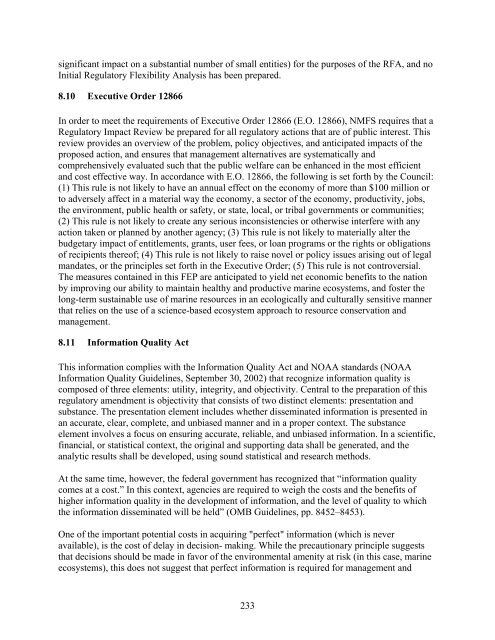Hawaii FEP - Western Pacific Fishery Council
Hawaii FEP - Western Pacific Fishery Council
Hawaii FEP - Western Pacific Fishery Council
Create successful ePaper yourself
Turn your PDF publications into a flip-book with our unique Google optimized e-Paper software.
significant impact on a substantial number of small entities) for the purposes of the RFA, and noInitial Regulatory Flexibility Analysis has been prepared.8.10 Executive Order 12866In order to meet the requirements of Executive Order 12866 (E.O. 12866), NMFS requires that aRegulatory Impact Review be prepared for all regulatory actions that are of public interest. Thisreview provides an overview of the problem, policy objectives, and anticipated impacts of theproposed action, and ensures that management alternatives are systematically andcomprehensively evaluated such that the public welfare can be enhanced in the most efficientand cost effective way. In accordance with E.O. 12866, the following is set forth by the <strong>Council</strong>:(1) This rule is not likely to have an annual effect on the economy of more than $100 million orto adversely affect in a material way the economy, a sector of the economy, productivity, jobs,the environment, public health or safety, or state, local, or tribal governments or communities;(2) This rule is not likely to create any serious inconsistencies or otherwise interfere with anyaction taken or planned by another agency; (3) This rule is not likely to materially alter thebudgetary impact of entitlements, grants, user fees, or loan programs or the rights or obligationsof recipients thereof; (4) This rule is not likely to raise novel or policy issues arising out of legalmandates, or the principles set forth in the Executive Order; (5) This rule is not controversial.The measures contained in this <strong>FEP</strong> are anticipated to yield net economic benefits to the nationby improving our ability to maintain healthy and productive marine ecosystems, and foster thelong-term sustainable use of marine resources in an ecologically and culturally sensitive mannerthat relies on the use of a science-based ecosystem approach to resource conservation andmanagement.8.11 Information Quality ActThis information complies with the Information Quality Act and NOAA standards (NOAAInformation Quality Guidelines, September 30, 2002) that recognize information quality iscomposed of three elements: utility, integrity, and objectivity. Central to the preparation of thisregulatory amendment is objectivity that consists of two distinct elements: presentation andsubstance. The presentation element includes whether disseminated information is presented inan accurate, clear, complete, and unbiased manner and in a proper context. The substanceelement involves a focus on ensuring accurate, reliable, and unbiased information. In a scientific,financial, or statistical context, the original and supporting data shall be generated, and theanalytic results shall be developed, using sound statistical and research methods.At the same time, however, the federal government has recognized that “information qualitycomes at a cost.” In this context, agencies are required to weigh the costs and the benefits ofhigher information quality in the development of information, and the level of quality to whichthe information disseminated will be held” (OMB Guidelines, pp. 8452–8453).One of the important potential costs in acquiring "perfect" information (which is neveravailable), is the cost of delay in decision- making. While the precautionary principle suggeststhat decisions should be made in favor of the environmental amenity at risk (in this case, marineecosystems), this does not suggest that perfect information is required for management and233












